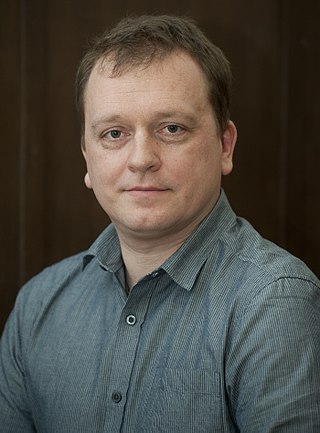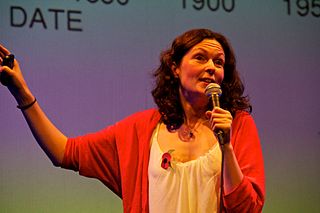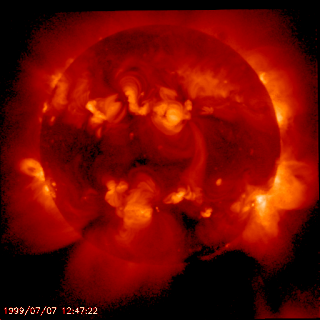Related Research Articles

A coronal mass ejection (CME) is a significant ejection of magnetic field and accompanying plasma mass from the Sun's corona into the heliosphere. CMEs are often associated with solar flares and other forms of solar activity, but a broadly accepted theoretical understanding of these relationships has not been established.
Solar physics is the branch of astrophysics that specializes in the study of the Sun. It deals with detailed measurements that are possible only for our closest star. It intersects with many disciplines of pure physics, astrophysics, and computer science, including fluid dynamics, plasma physics including magnetohydrodynamics, seismology, particle physics, atomic physics, nuclear physics, stellar evolution, space physics, spectroscopy, radiative transfer, applied optics, signal processing, computer vision, computational physics, stellar physics and solar astronomy.

Konkoly Observatory is an astronomical observatory located in Budapest, Hungary is part of the Research Centre for Astronomy and Earth Sciences and belongs to the Eötvös Loránd Kutatási Hálózat. It was founded in 1871 by Hungarian astronomer Miklós Konkoly-Thege (1842–1916) as a private observatory, and was donated to the state in 1899. Konkoly Observatory, officially known as ELKH CSFK Konkoly Thege Miklós Csillagászati Intézet in Hungarian, is the largest astronomical research institute in Hungary, and hosts the largest telescopes in the country. The Observatory has more than 60 researchers, a quarter of them are non-Hungarian.

Astronomical Observatory of Trieste is an astronomical center of studies located in the city of Trieste in northern Italy.
Eric Ronald Priest is Emeritus Professor at St Andrews University, where he previously held the Gregory Chair of Mathematics and a Bishop Wardlaw Professorship.

Krisztián Sárneczky is a Hungarian teacher of geography and prolific discoverer of minor planets and supernovae, researching at Konkoly Observatory in Budapest, Hungary. He is a board member of the Hungarian Astronomical Association (HAA) and member of the American Association of Variable Star Observers, leader of the Comet Section of the HAA, and is a contributor in the editorial work of Hungarian Astronomical Almanach.
The UCL Mullard Space Science Laboratory (MSSL) is the United Kingdom's largest university space research group. MSSL is part of the Department of Space and Climate Physics at University College London (UCL), one of the first universities in the world to conduct space research. Since its establishment, MSSL has participated in 35 satellite missions, 10 of which are currently in operation, and in over 200 sounding rocket experiments.
Dame Carole Jordan,, is a British physicist, astrophysicist, astronomer and academic. Currently, she is Professor Emeritus of Astrophysics at the University of Oxford and Emeritus Fellow at Somerville College, Oxford. From 1994 to 1996, she was President of the Royal Astronomical Society; she was the first woman to hold this appointment. She won the Gold Medal of the Royal Astronomical Society in 2005; she was only the third female recipient following Caroline Herschel in 1828 and Vera Rubin in 1996. She was head of the Rudolf Peierls Centre for Theoretical Physics at the University of Oxford from 2003 to 2004 and 2005 to 2008, and was one of the first female professors in Astronomy in Britain. She was made a Dame Commander of the Order of the British Empire in 2006 for services to physics and astronomy.
An active region is a temporary region in the Sun's atmosphere characterized by a strong and complex magnetic field. They are often associated with sunspots and are commonly the source of violent eruptions such as coronal mass ejections and solar flares. The number and location of active regions on the solar disk at any given time is dependent on the solar cycle.

Solar Physics is a peer-reviewed scientific journal published monthly by Springer Science+Business Media. The editors-in-chief are Lidia van Driel-Gesztelyi, John Leibacher (National Solar Observatory, and Institut d'Astrophysique Spatiale), Cristina Mandrini (Universidad de Buenos Aires), and Iñigo Arregui.

Lucinda "Lucie" May Green is a British science communicator and solar physicist.
Debrecen Heliophysical Observatory is an astronomical observatory owned and operated by Konkoly Thege Miklós Astronomical Institute of Hungarian Academy of Sciences. The Observatory provides solar data and images of observation. Study solar flares and sunspots.

Louise Harra is a Northern Irish physicist, born in Lurgan, County Armagh, Northern Ireland. She is the Director of the World Radiation Centre of the Physical Meteorological Observatory in Davos (PMOD/WRC) and affiliated professor at the Institute of Particle Physics and Astrophysics of ETH Zurich.

The European Solar Physics Division (ESPD) of the European Physical Society (EPS), is an organisation whose purpose is to promote solar physics and represent European scientists interested in the physics of the Sun. The ESPD is known mostly for its organisation of the European Solar Physics Meetings, which bring together European solar physicists and take place every three years.

Sheila Pearson is a British astronomer and the Education, Outreach and Diversity Officer at the Royal Astronomical Society.

The Community of European Solar Radio Astronomers (CESRA) is a non-profit informal organization of European scientists whose aims are to promote studies of solar radio physics and related topics.
Sarah Anna Matthews is a British physicist. She is professor and head of solar physics at University College London's Mullard Space Science Laboratory (MSSL). She is also chairperson of UK Solar Physics.

In solar physics, a transequatorial loop is a structure present in the solar corona that connects two different regions of opposite magnetic polarity in opposite hemispheres of the Sun. These connected regions are not limited to active regions, but are most commonly found during the times of maximum solar activity, the solar maximum.
Cristina Hemilse Mandrini is an Argentinian solar physicist. She is currently a researcher at the Argentinian National Council for Scientific and Technical Research (CONICET) and a professor at the University of Buenos Aires.
Caitriona Jackman is an Irish space physicist. In 2021, she became the first female senior professor at the Dublin Institute for Advanced Studies (DIAS) Dunsink Observatory. She has made important contributions to understanding the solar wind interactions with planetary magnetospheres.
References
- 1 2 "Solar Physics". Springer. Retrieved 2019-10-15.
- 1 2 3 "International Astronomical Union | IAU". www.iau.org. Retrieved 2019-10-15.
- ↑ "SOLar and STellar Activity Research Team at Konkoly Observatory". konkoly.hu. Retrieved 2019-10-15.
- 1 2 UCL (2018-11-20). "Prof. Lidia Van Driel-Gesztelyi". UCL Department of Space and Climate Physics. Retrieved 2019-10-15.
- ↑ "Lidia van Driel-Gesztelyi - Google Scholar Citations". scholar.google.com. Retrieved 2019-10-15.
- ↑ Démoulin, P.; Mandrini, C. H.; Driel-Gesztelyi, L. van; Thompson, B. J.; Plunkett, S.; Kővári, Zs; Aulanier, G.; Young, A. (2002-02-01). "What is the source of the magnetic helicity shed by CMEs? The long-term helicity budget of AR 7978". Astronomy & Astrophysics. 382 (2): 650–665. Bibcode:2002A&A...382..650D. doi: 10.1051/0004-6361:20011634 . hdl: 11336/22443 . ISSN 0004-6361.
- ↑ Williams, David R.; Török, Tibor; Démoulin, Pascal; Driel-Gesztelyi, Lidia van; Kliem, Bernhard (2005-07-22). "Eruption of a Kink-unstable Filament in NOAA Active Region 10696". The Astrophysical Journal Letters. 628 (2): L163. arXiv: astro-ph/0507661 . Bibcode:2005ApJ...628L.163W. doi: 10.1086/432910 . ISSN 1538-4357.
- ↑ "Annual Reviews Directory". www.annualreviews.org. Retrieved 2019-10-17.
- ↑ "RAS Awards: recipients profiles: Lidia van Driel-Gesztelyi | The Royal Astronomical Society". ras.ac.uk. Retrieved 2019-10-15.
- ↑ "ISSI Annual Report" (PDF).